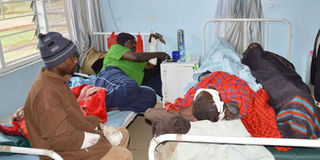Patients cry over rot in Kiambu hospitals

Patients share beds at Kiambu Level Five Hospital. Some have expressed fears of contracting diseases while at the hospital. PHOTO | ERIC WAINAINA | NATION MEDIA GROUP
What you need to know:
- The hospitals are grappling with congestion, poor services, broken down equipment and an acute shortage of drugs.
- In some hospitals in Kiambu and Tigoni, patients are asked to buy blankets.
- At the Level Five Hospital maternity wing, where a woman died recently, the Nation found up to three mothers sharing a bed.
Two expectant women per bed.
Two infants and their mothers, one bed.
Two adult patients a bed. A plate of a small piece of ugali, a handful beans and overcooked cabbage filled with tasteless thin soup for dinner.
This is the reality at Kiambu Level Five and most of the 117 hospitals in the county.
And this is despite the Health department having an annual budget of Sh4 billion.
The hospitals are grappling with congestion, poor services, broken down equipment and an acute shortage of drugs.
Months ago, the county government said it bought drugs valued at Sh134 million. The trucks loaded with the drugs were flagged off by Governor Ferdinand Waititu on October 17, 2017 and May 22, 2018.
In some hospitals in Kiambu and Tigoni, patients are asked to buy blankets.
On Tuesday last week, patients at Lari Hospital were given porridge. The hospital could not afford any other meal as suppliers were on a go-slow.
FINANCE TRIPS
Nyathuna Ward Representative Edie Kinyanjui, who is also the County Assembly Health Committee chairman, said food and drugs are in short supply and that contractors are owed more than Sh100 million by the devolved government.
The county government has in recent months used millions of shillings to finance trips by executive members and MCAs to Naivasha, Mombasa and overseas.
At the Level Five Hospital maternity wing, where a woman died recently, the Nation found up to three mothers sharing a bed.
They spend most of their time standing or seated on the floor to give one another a chance and space to sleep.
Those who spoke to the Nation sought anonymity. Many complained of bad food and lack of drugs for them and their babies.
Patients are usually referred to private clinics, which dot the area around the hospital.
PRIVATE CLINICS
“How do they expect us to be comfortable? The beds are too small to be shared, One can also contract a disease while in hospital,” one woman said.
Tigoni Hospital does not have a scanner and the women are usually referred to private clinics in Limuru, about four kilometres away.
At the Level Five Hospital Paediatric Unit where two doctors and a nurse recently declared a living baby dead and a burial permit issued, two to three children share a bed.
Ms Elizabeth Wanjiru's four-year-old boy was admitted to the hospital on Wednesday and has been sharing a bed with a six-year-old girl.
The children face opposite directions when sleeping as their mothers spend time standing or sitting around them during the day.
At night, the women remain standing at a separate section of the ward.
SHARE BEDS
At the male Nyayo Ward in the same hospital, Mr Joseph Gitau from Mathari and Mr Michael Munga from Kwa-Mbira village in Limuru also share a bed.
“This has been the situation from the time we arrived. We are now used to it,” said Mr Gitau, who was admitted to the hospital two months ago with a leg fracture.
He is yet to undergo surgery even after paying Sh2,500.
Mr Munga said he and other patients do not get enough food and have to rely on visiting relatives.
Some of Kiambu County government’s six advanced ambulances, which were bought at Sh40 million, have been vandalised and reduced to patient carriers.
During their launch in Lusengeti on January 23, county health officials said the ambulances were equipped with intensive care units and could support a patient’s life for five hours.
The six ambulances are a pale shadow of their former selves.
One of the ambulances the Nation team photographed has one passenger seat and a long bench on one side.
DENIED REPORTS
A doctor contacted said while referring the sick to other hospitals, they have to hunt for equipment within the hospital and fix them in the ambulance “and hope the gadgets will support the patient reach his or her destination”.
Despite the overwhelming evidence, Kiambu Health executive Joseph Murega and County chief officer Andrew Toro denied reports of hospitals lacking food.
The two top county officials, however, said public hospitals are overstretched.
They blamed the problem on an influx of patients from Nairobi, Murang’a, Nakuru and Machakos “who have been eating into the county health budget, but everything is under control”.
TAINT IMAGE
According to Dr Toro, the hospitals treat approximately 10,000 people every day.
He added that at any given time, the hospitals have 3,000 patients, with 50 per cent coming from neighbouring counties.
Dr Toro also accused some health workers of sabotaging services in public hospitals.
“Many of them run clinics and they have been tainting the image of our health centres so that patients flood their hospitals,” he said.




